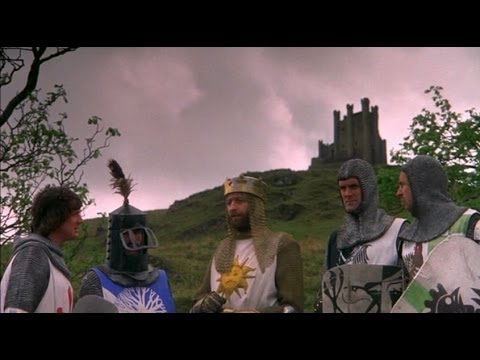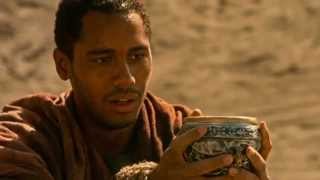|
The realm of King Arthur lies on the border of folklore and history. Its stories are brought to life in the pages of literature and echoing in the wind over the archeological sites of Cadbury Hillfort (Camelot) and Glastonbury Tor (Avalon). It is a place of magic and chivalric ideals of behavior and leadership, woven into the songs of minstrels so that all of medieval Europe knew of King Arthur and his knights. Here be wondrous tournaments and adventures for the mysterious questing beast, or the otherworldly Grail, or to rescue a fair damosel in distress. Knights in shining armor display great feats of strength and chivalry, right judgement, and courtly love. In Camelot, striving for your best self, for trouthe (integrity), is the utmost ideal. It is no wonder that Once Upon a Time, a show known for its unique twists on fairy tale characters, has reached into the mists to draw out King Arthur, Queen Guinevere, Merlin and the Knights of the Round Table. Unfortunately, in Season 5a, the show has presented a very warped view of the medieval ideal of Camelot and chivalric leadership. Aerial View of Cadbury Castle. The hill can be seen from Glastonbury Tor. Medieval romance literature is dominated by the stories of King Arthur and his knights (Loomis). In fact, one of the first books printed by William Caxton, who brought the printing press to England, was Sir Thomas Malory's Le Morte Darthur. King Arthur was a larger-than-life, idealized ruler in all of his legends which span the course of the Middle Ages. As such, the character of King Arthur transforms according to the ideals of the culture at the time. For example, early medieval England was still a land of combat and warfare, recently affected by the Norman Invasion of 1066. In the Historia Regum Brittaniae, or the History of the Kings of Britain, a pseudo-history written by Geoffrey of Monmouth circa 1100, Arthur is a great warrior-king, able to slay 100 men at a single stroke of his sword Caliburn (the prototype for Excalibur). By the end of the Middle Ages, in Sir Thomas Malory's Le Morte Darthur, Arthur is the philosopher-king, the head of a great court who metes out justice with good judgment and wisdom, an ideal of chivalric behavior by example for his knights. He is so idealized that there is only one time that Arthur shows human fallibility: he becomes angry when he realizes that Lancelot and Guinevere are having an affair. But although he is "wonderly wroth," he chooses to not act on this anger out of love and friendship, for both his wife and his best knight. However, later on when a group of knights, led by Mordred and Aggravaine, confront Arthur about the illicit affair, he can no longer ignore it and is forced to banish Lancelot and punish Guinevere with burning at the stake for the good of his kingdom. Treason was the utmost sin in medieval eyes, and as ideal ruler King Arthur had to deal with it harshly, no matter what his briefly glimpsed personal feelings may be. The ideal king: noble, chivalrous, and upholding trouthe. Quite the contrast from the first picture above, isn't he? Once Upon a Time usually does a fabulous job at humanizing fairy tale and literary characters, giving them depth with both positive traits and tragic flaws through their backstories and current storylines. However, Arthur's humanization in the show made him the total opposite of the ideal philosopher-king of the Late Middle Ages. Instead, his striving for the ideal kingdom is twisted by selfishness and narrow-mindedness; he attempts, and unfortunately succeeds, in getting what he wants through trickery time and time again. He is the polar opposite of the chivalric ideal. His determination is warped into a maniacal hunger for power. While this may suit a portrayal of some actual leaders, albeit in a caricature type of way--Arthur not only acts but looks crazed in his scenes, especially towards the end of Season 5a. It is a denigration of a great legendary figure and the ideals that he represented. (I have included a list of suggested reading to get a true feel for the magic of medieval Arthurian romance at the end of this essay.) Treachery most foul. Treason was the ultimate crime in medieval society. Dante even assigned the last circle of hell in his Inferno to the cold-hearted treacherous! If Arthur was the ideal leader, then Camelot was the ideal realm. It was the beginning and return of all quests, especially the Quest for the Holy Grail, which according to Malory appeared in King Arthur's court as a beacon and beckoning to adventure. In Once Upon a Time, we see the beginnings of a fortified town, which is actually quite a historical view of how castles were founded. It implies the toil of not only Arthur and his knights but the people they led and protected as well, which is the symbiotic nature of the feudal system. But that effort seems to be wasted when OUAT's Arthur decides the best way to advance his kingdom is to build it instantly with magic. In a beautiful scene, spires and fortifications appear, but it only serves to show how Arthur is willing to cheat to get what he wants. In medieval Arthurian romance, the end most certainly does not justify the means. The only saving grace that can be found in this creation of Camelot is perhaps the message that ideal realms are like castles in the air: not real, but only figments of the imagination meant to inspire. "On second thought, let's not go to Camelot. 'Tis a silly place." The brilliant Monty Python and the Holy Grail. The treatment of the Grail was perhaps the most inspirational moment in all the Arthurian scenes in Once Upon a Time's Season 5a. Merlin and a companion are lost in a desert wasteland, desperate for water and shelter, when they see a cup of water. The companion grabs the cup and suffers the deadly consequences. Merlin, on the other hand, drops to his knees and begs for a sip from the cup if he is worthy. One of the biggest themes in the Grail legend is the humility of the questing knight, the striving to be one's best self while recognizing there are mysterious powers greater than one's self. It is Merlin's humility and selflessness in that moment that makes him worthy of the blessings of the Grail. In many of the Grail legends, the questing knight must travel through a Wasteland, the symbolic landscape of spiritual emptiness, a cup waiting to be filled. The Grail itself in medieval romance is the symbol of fertility, and it holds the power of healing and life. In drinking from the cup, OUAT's Merlin is given both his magical powers and longevity, and the Wasteland is transformed into a lush green oasis. This was a wonderful visual interpretation of the meaning within the Grail quest. The Arming and Departure of the Knights, one of six Grail tapestries by Edward Burne-Jones. In humanizing King Arthur, Once Upon a Time went too far, creating an obsessive leader who would stoop to treachery and trickery, deluding himself that it is for the good of the Camelot. It is a shame that an idealized hero of medieval romance would be portrayed as a dastardly villain, devoid of the integrity that was the most important part of the Code of Chivalry; one can only hope that Season 5b will show some sort of redemption for this version of King Arthur. The damage may already have been done, however: unlike the main, complex "villains," Regina and Rumple, King Arthur is so far from his literary counterpart and shows no likeable traits, so it is hard to root for his redemption. The true magic and meaning of medieval Arthurian romance was shown not in Once Upon a Time's King Arthur or Camelot, but in the small scene of Merlin and the Grail, where we see the fruits of striving for one's best self. Merlin stares in humble awe and wonder at the Grail. Another contrast to the first picture above. Works Cited/Referenced Loomis, Arthur Sherman. Celtic Myth and Arthurian Romance. London: Constable, 1993. Fitzgerald, Lori. The Transformation of King Arthur in Five Works of Medieval Literature. Brooklyn: St. Joseph's College, 1994. Suggested Reading; 1. Sir Thomas Malory's Le Morte Darthur...the definitive work of medieval Arthurian romance. 2. Howard Pyle's The Story of King Arthur and His Knights...an excellent book to introduce younger readers (10 and up) to the legend. (Sidenote: Pyle's The Merry Adventures of Robin Hood is also highly recommended. In it he compiles the medieval outlaw ballads into a comprehensive text, also for younger readers.) 3. T.H. White's The Once and Future King. Here you see the humanization of Arthur done correctly. Also suitable for younger readers. Lori J. Fitzgerald is a Staff Writer at Once Upon a Fan, a fantasy author, and a former English teacher. Her novelettes Love Lies Bleeding and Songs Within Stone have five star reviews from an Amazon Top 500 Reviewer. These stories and her debut work The Dragon's Message can be read on Amazon Kindle and are free on Kindle Unlimited. You can find out more about her writing on her Amazon Author Page: www.amazon.com/author/lorifitzgerald.
Lori lives in New York with her husband, two bookworm children, and a little black puppy they just rescued (who is tugging on her sock as she types this).
1 Comment
Leisa
20/2/2016 23:47:15
Nice article. OUAT's King Arthur is pretty unlikable. Not only does he betray his wife by using magic on her, but he kills King Fergus (beloved father of Merida) and he essentially kills Killian by striking the mortal blow with Excalibur. I know OUAT is famous (or infamous) for twisting stories and characters, but their Arthur thus far has no redeemimg qualities. Most villains on Once have at least been fleshed out or given some sympathetic back story, but Arthur is in the same category with Peter Pan and Cruella. It does seem a shame to have taken such a beloved character and make him a moustache twirling villain.
Reply
Leave a Reply. |
OriginsExplore the Arthurian legend surrounding Lancelot, take a trip into the woods to discover the mythology behind Red Riding Hood or learn more about a modern day hero called Snow White. Origins provides unique insights and perspectives from talented writers into the characters we know and love, going far beyond the boundaries of Storybrooke. Archives
August 2016
Categories
All
|








